display RENAULT MASTER 2018 Owners Manual
[x] Cancel search | Manufacturer: RENAULT, Model Year: 2018, Model line: MASTER, Model: RENAULT MASTER 2018Pages: 290, PDF Size: 7.1 MB
Page 76 of 290
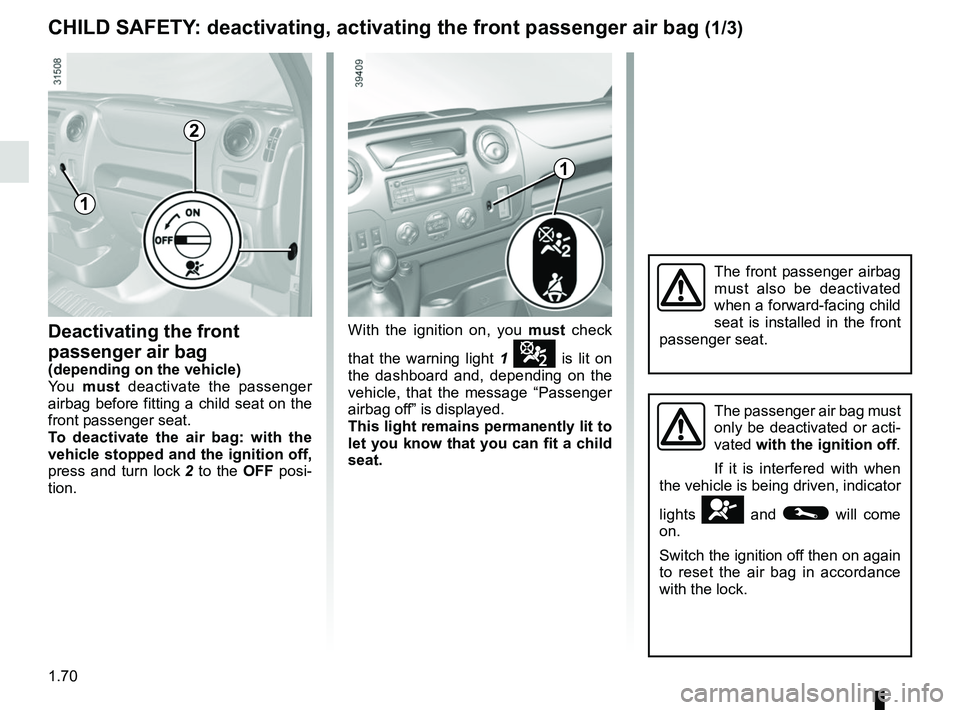
1.70
Deactivating the front
passenger air bag
(depending on the vehicle)
Yo u must deactivate the passenger
airbag before fitting a child seat on the
front passenger seat.
To deactivate the air bag: with the
vehicle stopped and the ignition off,
press and turn lock 2 to the OFF posi-
tion. With the ignition on, you
must check
that the warning light 1 ¹ is lit on
the dashboard and, depending on the
vehicle, that the message “Passenger
airbag off” is displayed.
This light remains permanently lit to
let you know that you can fit a child
seat.
CHILD SAFETY: deactivating, activating the front passenger air bag (1/3)
1
2
The front passenger airbag
must also be deactivated
when a forward-facing child
seat is installed in the front
passenger seat.
The passenger air bag must
only be deactivated or acti-
vated with the ignition off.
If it is interfered with when
the vehicle is being driven, indicator
lights
å and © will come
on.
Switch the ignition off then on again
to reset the air bag in accordance
with the lock.
1
Page 87 of 290
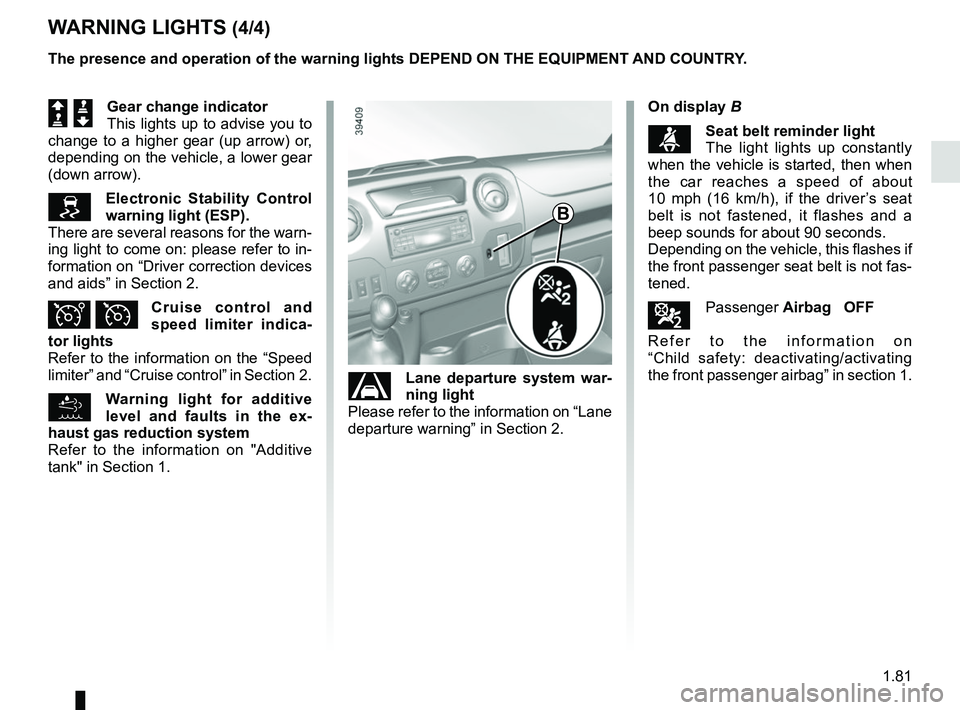
1.81
WARNING LIGHTS (4/4)
Š ‰Gear change indicator
This lights up to advise you to
change to a higher gear (up arrow) or,
depending on the vehicle, a lower gear
(down arrow).
Electronic Stability Control
warning light (ESP).
There are several reasons for the warn-
ing light to come on: please refer to in-
formation on “Driver correction devices
and aids” in Section 2.
Î ÏCruise control and
speed limiter indica-
tor lights
Refer to the information on the “Speed
limiter” and “Cruise control” in Section 2.
Warning light for additive
level and faults in the ex-
haust gas reduction system
Refer to the information on "Additive
tank" in Section 1.
The presence and operation of the warning lights DEPEND ON THE EQUIPMENT\
AND COUNTRY.
Lane departure system war-
ning light
Please refer to the information on “Lane
departure warning” in Section 2.
B
On display B
ßSeat belt reminder light
The light lights up constantly
when the vehicle is started, then when
the car reaches a speed of about
10 mph (16 km/h), if the driver’s seat
belt is not fastened, it flashes and a
beep sounds for about 90 seconds.
Depending on the vehicle, this flashes if
the front passenger seat belt is not fas-
tened.
¹Passenger Airbag OFF
Refer to the information on
“Child safety: deactivating/activating
the front passenger airbag” in section 1.
Page 88 of 290
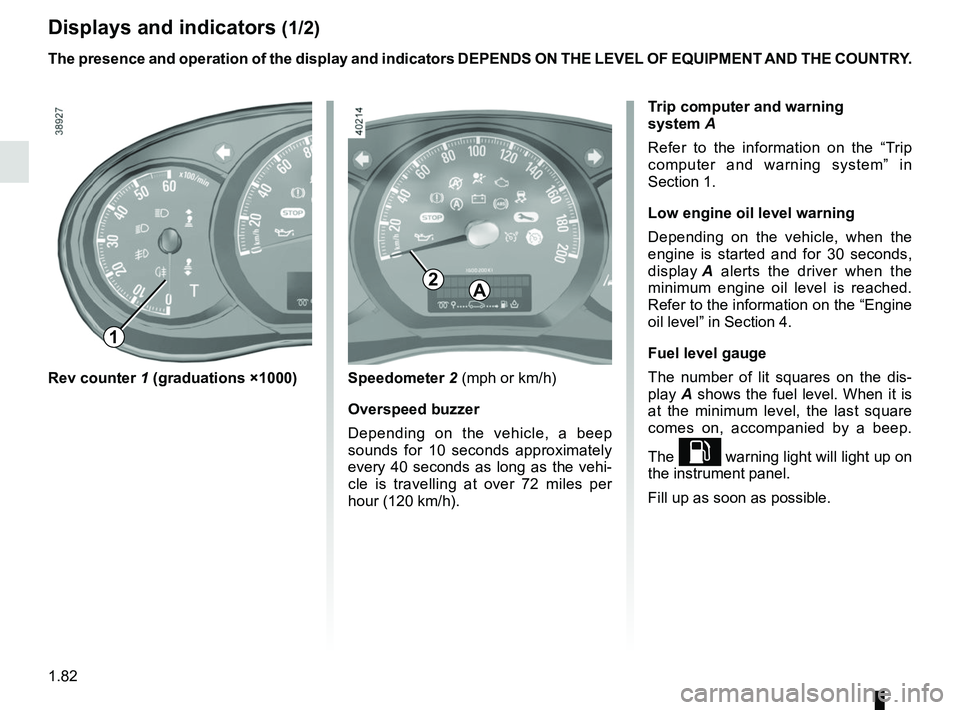
1.82
Displays and indicators (1/2)
Rev counter 1 (graduations ×1000) Speedometer 2 (mph or km/h)
Overspeed buzzer
Depending on the vehicle, a beep
sounds for 10 seconds approximately
every 40 seconds as long as the vehi-
cle is travelling at over 72 miles per
hour (120 km/h).
2
1
The presence and operation of the display and indicators DEPENDS ON THE \
LEVEL OF EQUIPMENT AND THE COUNTRY.
Trip computer and warning
system A
Refer to the information on the “Trip
computer and warning system” in
Section 1.
Low engine oil level warning
Depending on the vehicle, when the
engine is started and for 30 seconds,
display A alerts the driver when the
minimum engine oil level is reached.
Refer to the information on the “Engine
oil level” in Section 4.
Fuel level gauge
The number of lit squares on the dis-
play A shows the fuel level. When it is
at the minimum level, the last square
comes on, accompanied by a beep.
The
L warning light will light up on
the instrument panel.
Fill up as soon as possible.
A
Page 89 of 290
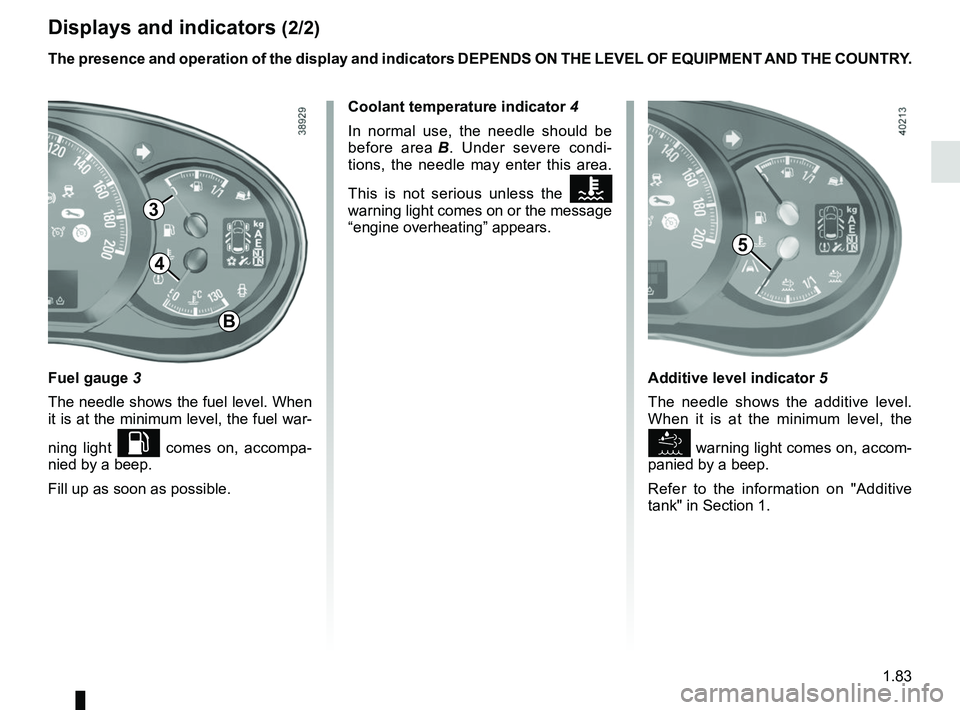
1.83
Displays and indicators (2/2)
Fuel gauge 3
The needle shows the fuel level. When
it is at the minimum level, the fuel war-
ning light
L comes on, accompa-
nied by a beep.
Fill up as soon as possible. The presence and operation of the display and indicators DEPENDS ON THE \
LEVEL OF EQUIPMENT AND THE COUNTRY.
3
4
B
Coolant temperature indicator 4
In normal use, the needle should be
before area B. Under severe condi-
tions, the needle may enter this area.
This is not serious unless the
Ô
warning light comes on or the message
“engine overheating” appears.
Additive level indicator 5
The needle shows the additive level.
When it is at the minimum level, the
warning light comes on, accom-
panied by a beep.
Refer to the information on "Additive
tank" in Section 1.
5
Page 90 of 290
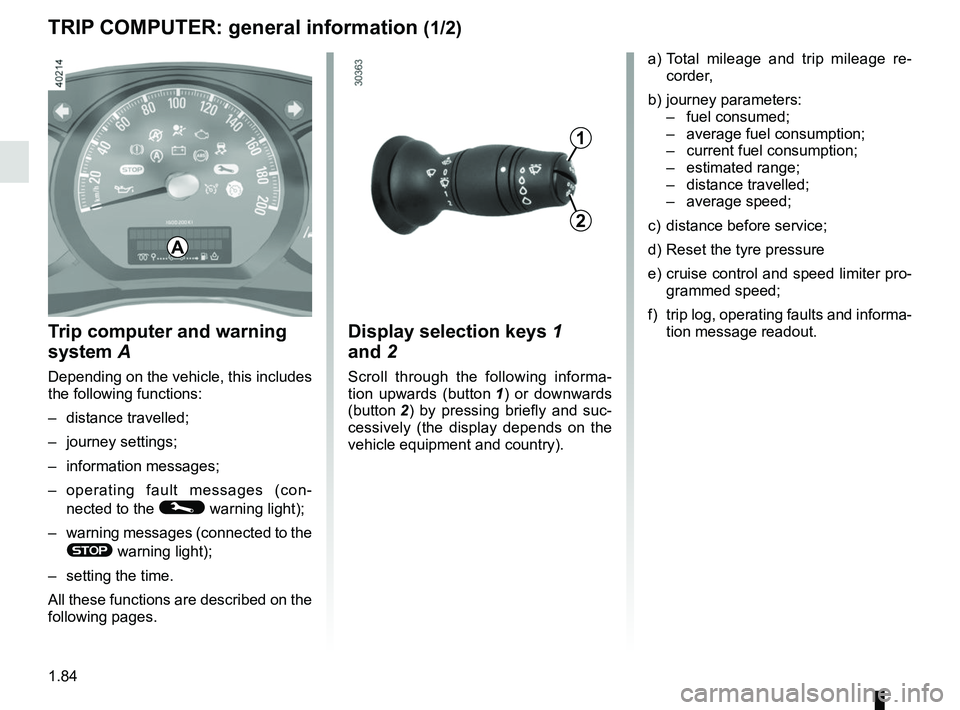
1.84
TRIP COMPUTER: general information (1/2)
Trip computer and warning
system A
Depending on the vehicle, this includes
the following functions:
– distance travelled;
– journey settings;
– information messages;
– operating fault messages (con-
nected to the
© warning light);
– warning messages (connected to the
® warning light);
– setting the time.
All these functions are described on the
following pages.
Display selection keys 1
and 2
Scroll through the following informa-
tion upwards (button 1) or downwards
(button 2 ) by pressing briefly and suc-
cessively (the display depends on the
vehicle equipment and country). a) Total mileage and trip mileage re-
corder,
b) journey parameters: – fuel consumed;
– average fuel consumption;
– current fuel consumption;
– estimated range;
– distance travelled;
– average speed;
c) distance before service;
d) Reset the tyre pressure
e) cruise control and speed limiter pro- grammed speed;
f) trip log, operating faults and informa- tion message readout.
A
1
2
Page 91 of 290
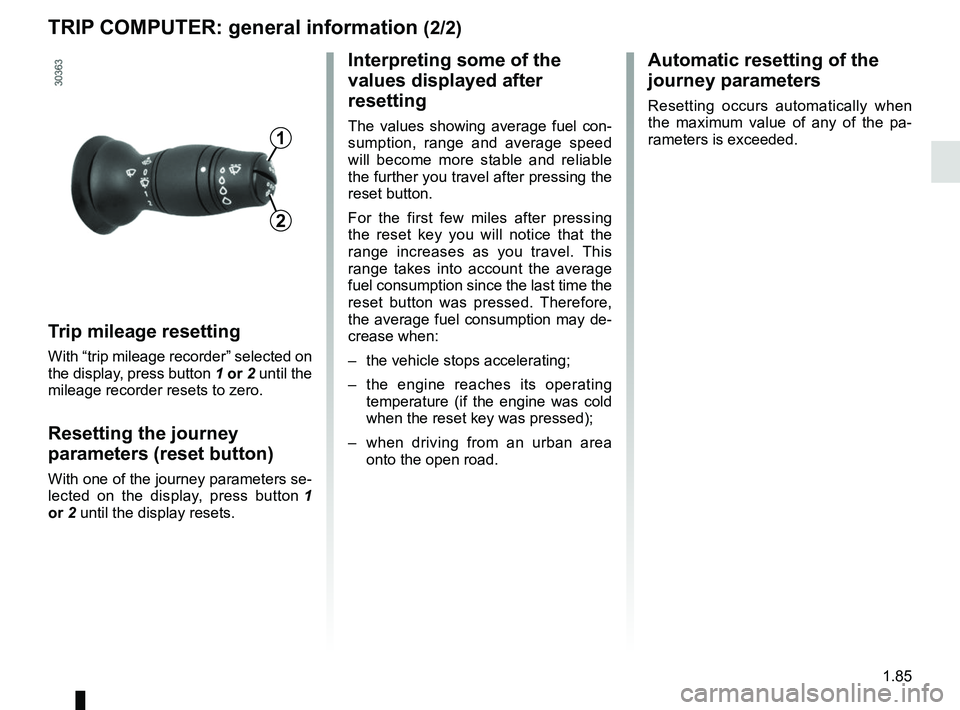
1.85
TRIP COMPUTER: general information (2/2)
Trip mileage resetting
With “trip mileage recorder” selected on
the display, press button 1 or 2 until the
mileage recorder resets to zero.
Resetting the journey
parameters (reset button)
With one of the journey parameters se-
lected on the display, press button 1
or 2 until the display resets.
Interpreting some of the
values displayed after
resetting
The values showing average fuel con-
sumption, range and average speed
will become more stable and reliable
the further you travel after pressing the
reset button.
For the first few miles after pressing
the reset key you will notice that the
range increases as you travel. This
range takes into account the average
fuel consumption since the last time the
reset button was pressed. Therefore,
the average fuel consumption may de-
crease when:
– the vehicle stops accelerating;
– the engine reaches its operating
temperature (if the engine was cold
when the reset key was pressed);
– when driving from an urban area
onto the open road.
Automatic resetting of the
journey parameters
Resetting occurs automatically when
the maximum value of any of the pa-
rameters is exceeded.
1
2
Page 92 of 290
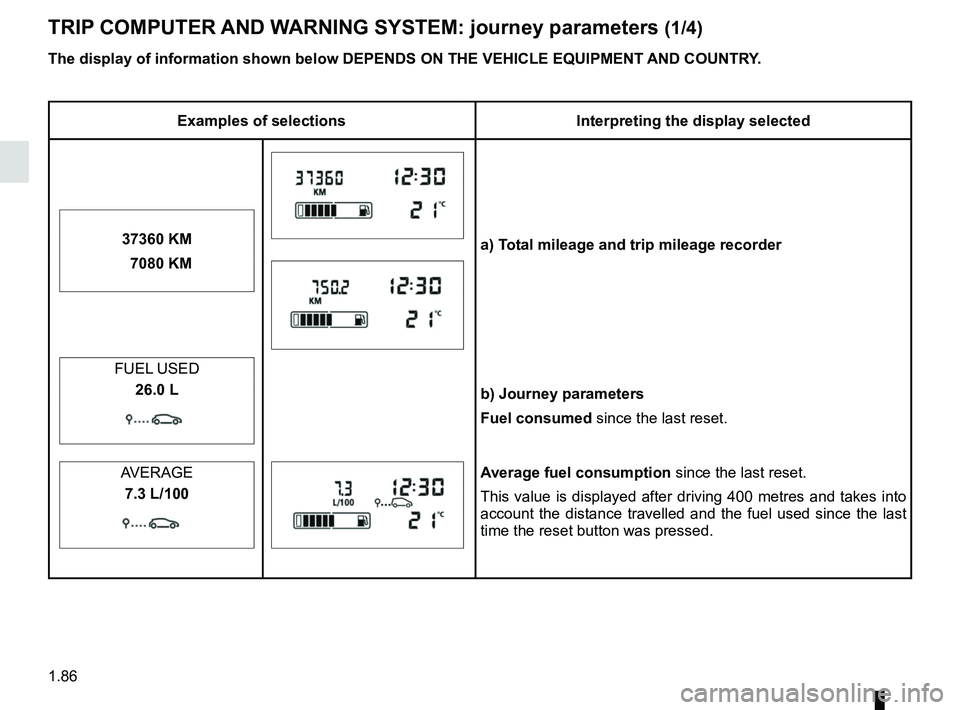
1.86
TRIP COMPUTER AND WARNING SYSTEM: journey parameters (1/4)
The display of information shown below DEPENDS ON THE VEHICLE EQUIPMENT \
AND COUNTRY.
Examples of selectionsInterpreting the display selected
a) Total mileage and trip mileage recorder
37360 KM
7080 KM
b) Journey parameters
Fuel consumed since the last reset.
FUEL USED
26.0 L
AVERAGEAverage fuel consumption since the last reset.
This value is displayed after driving 400 metres and takes into
account the distance travelled and the fuel used since the last
time the reset button was pressed.
7.3 L/100
Page 93 of 290
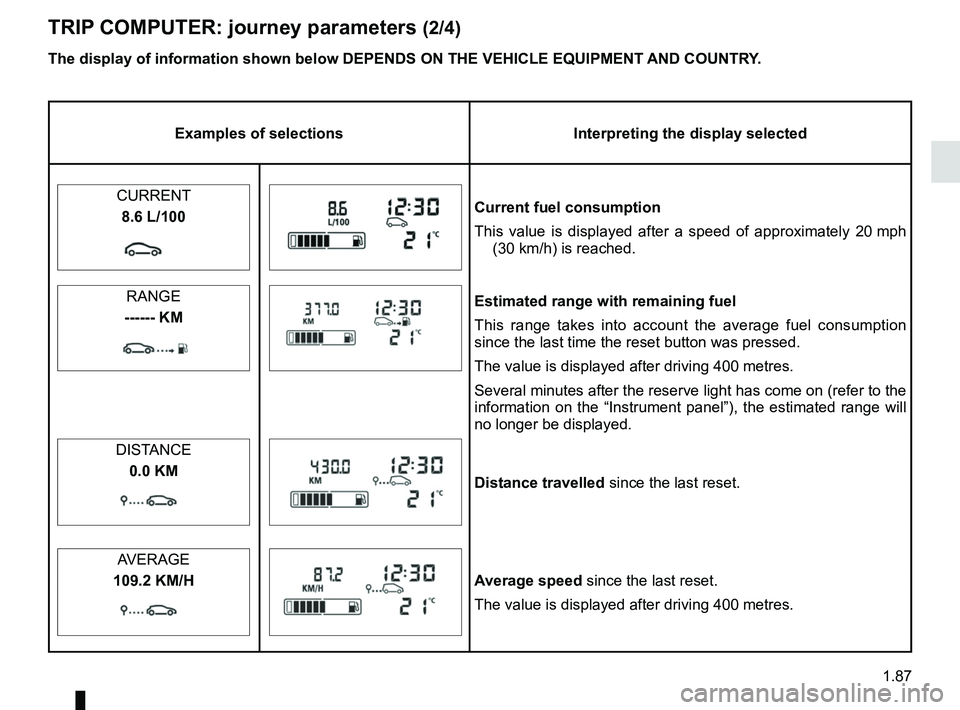
1.87
TRIP COMPUTER: journey parameters (2/4)
Examples of selectionsInterpreting the display selected
CURRENT
Current fuel consumption
This value is displayed after a speed of approximately 20 mph (30 km/h) is reached.
8.6 L/100
RANGE
Estimated range with remaining fuel
This range takes into account the average fuel consumption
since the last time the reset button was pressed.
The value is displayed after driving 400 metres.
Several minutes after the reserve light has come on (refer to the
information on the “Instrument panel”), the estimated range will \
no longer be displayed.
------ KM
DISTANCE
Distance travelled since the last reset.
0.0 KM
AVERAGE
Average speed
since the last reset.
The value is displayed after driving 400 metres.
109.2 KM/H
The display of information shown below DEPENDS ON THE VEHICLE EQUIPMENT \
AND COUNTRY.
Page 94 of 290
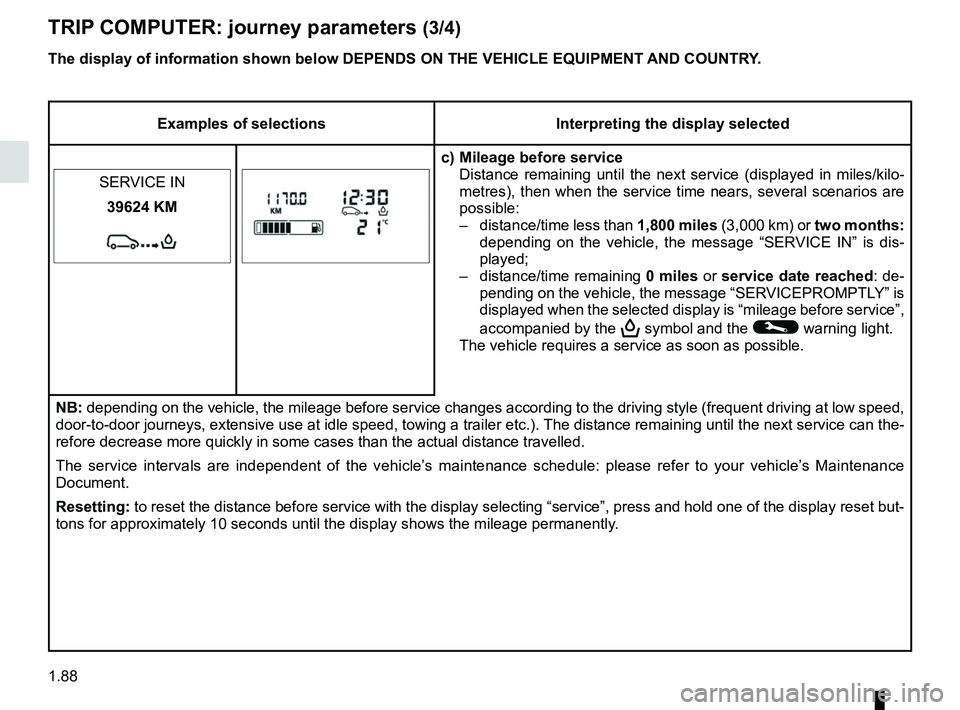
1.88
TRIP COMPUTER: journey parameters (3/4)
Examples of selectionsInterpreting the display selected
c) Mileage before service Distance remaining until the next service (displayed in miles/kilo-
metres), then when the service time nears, several scenarios are
possible:
– distance/time less than 1,800 miles (3,000 km) or two months:
depending on the vehicle, the message “SERVICE IN” is dis-
played;
– distance/time remaining 0 miles or service date reached : de-
pending on the vehicle, the message “SERVICEPROMPTLY” is
displayed when the selected display is “mileage before service”,
accompanied by the
9 symbol and the © warning light.
The vehicle requires a service as soon as possible.
SERVICE IN
39624 KM
NB: depending on the vehicle, the mileage before service changes according \
to the driving style (frequent driving at low speed,
door-to-door journeys, extensive use at idle speed, towing a trailer etc\
.). The distance remaining until the next service can t
he-
refore decrease more quickly in some cases than the actual distance trav\
elled.
The service intervals are independent of the vehicle’s maintenance schedule: please refer to your vehicle’s Maintenance
Document.
Resetting: to reset the distance before service with the display selecting “ser\
vice”, press and hold one of the display reset but-
tons for approximately 10 seconds until the display shows the mileage pe\
rmanently.
The display of information shown below DEPENDS ON THE VEHICLE EQUIPMENT \
AND COUNTRY.
Page 95 of 290
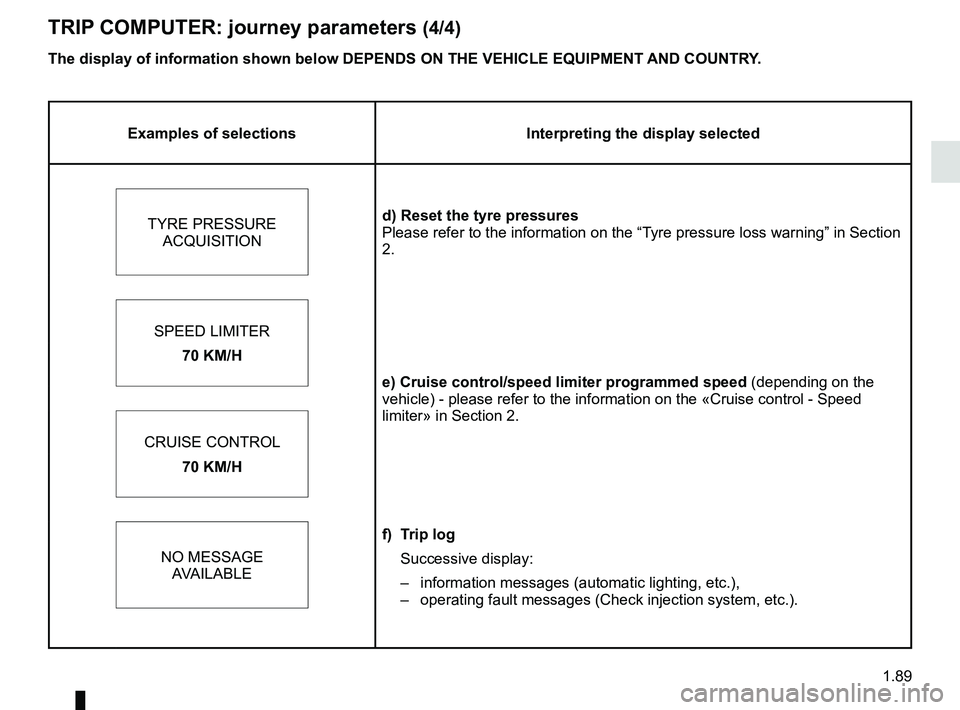
1.89
TRIP COMPUTER: journey parameters (4/4)
Examples of selectionsInterpreting the display selected
TYRE PRESSURE ACQUISITION d) Reset the tyre pressures
Please refer to the information on the “Tyre pressure loss warning” in Section
2.
SPEED LIMITER e) Cruise control/speed limiter programmed speed (depending on the
vehicle) - please refer to the information on the «Cruise control - \
Speed
limiter» in Section 2.
70 KM/H
CRUISE CONTROL 70 KM/H
NO MESSAGE AVAILABLE f) Trip log
Successive display:
– information messages (automatic lighting, etc.),
– operating fault messages (Check injection system, etc.).
The display of information shown below DEPENDS ON THE VEHICLE EQUIPMENT \
AND COUNTRY.